Music
Trailers
DailyVideos
India
Pakistan
Afghanistan
Bangladesh
Srilanka
Nepal
Thailand
StockMarket
Business
Technology
Startup
Trending Videos
Coupons
Football
Search
Download App in Playstore
Download App
Best Collections
Technology
Rivian, the buzzy electric vehicle startup that is backed by Amazon and Ford, is shutting down all of its facilities due to the spread of COVID-19, the disease caused by coronavirus.
Rivian employs more than 2,000 workers across several locations, including its headquarters in Plymouth, Mich., a factory in Normal, Ill. as well as operations in San Jose and Irvine, Calif., where engineers are working on autonomous vehicle technology. Rivian also has an office in the U.K.
The company said Friday that salaried and hourly employees will continue to be paid during the shutdown. Rivian told TechCrunch that most of its facilities have been at 2 to 5% occupancy for about a week. The length of the shutdown is undetermined at this time, a company spokesperson said.
Rivian spent the majority of its life in the shadows until November 2018, when it revealed its all-electric R1T pickup and R1S SUV at the LA Auto Show. Since then, the electric automaker has picked up investors and commercial customers such as Ford and Amazon, in addition to the reservations consumers have made for its pickup and SUV.
In December, Rivian announced it had raised $1.3 billion in new funding, the fourth round of capital announced by the company in 2019 alone. It followed prior announcements of $700 million led by Amazon, $500 million from Ford (which includes a collaboration on electric vehicle technology) and $350 million from Cox Automotive.
Lincoln, the luxury brand under Ford, is working with Rivian to develop an &all-new& electric vehicle. Amazon has ordered 100,000 all-electric delivery vans from Rivian, with the first deliveries expected to begin in 2021.
The global COVID-19 pandemic has prompted automakers to temporarily suspend operations in Europe and the U.S., where the disease has started to spread. In China, where the disease first started, factories are coming back online.
Automakers have had varied responses to the pandemic; some took action to suspend production faster than others. Honda kicked off closures in the U.S. Ford, GM and FCA followed after the Big 3 formed a task force with the United Auto Workers. Even as these automakers began implementing new safety precautions in its factories based on recommendations that came out of the task force, the UAW continued to pressure them to close. A couple of cases of employees testing positive for COVID-19 accelerated the closures. Nissan and Volkswagen have also paused operations in the U.S.
Tesla has been a notable holdout. The company announced Thursday it would shut down its Fremont, Calif. factory, beginning March 23. The decision to suspend production there came days after Alameda County officials issued an order to close all nonessential businesses. Tesla kept its doors open anyway, even after officials publicly said that it was not an essential business.
Tesla has suspended operations at its New York factory as well. Teslagigafactory near Reno, Nev., which produces electric motors and battery packs, is fully operational.
Tesla told employees in an email sent March 18, and viewed by TechCrunch, that it was staying open because it has had &conflicting guidance from different levels of government& over whether it could operate. The human resources department told employees in the email to come to work if their job is to produce, service, deliver or test its electric vehicles.
But by Thursday, and after meetings with county officials, the company announced it would suspend production. Some basic operations that will support Tesla&scharging infrastructure and what it describes as its &vehicle and energy services operations& will continue at the factory, which under normal circumstances has more than 10,000 people working there.

- Details
- Category: Technology Today
Read more: Rivian shuts down all facilities over COVID-19 pandemic concerns
Write comment (98 Comments)One of the obstacles to accurately estimating the prevalence of sickness in the general population is that most of our data comes from hospitals, not the 99.9 percent of the world that isn&t hospitals. FluSense is an autonomous, privacy-respecting system that counts the people and coughs in public spaces to keep health authorities informed.
Every year has a flu and cold season, of course, though this yearis of course far more dire. But itlike an ordinary flu season in that the main way anyone estimates how many people are sick is by analyzing stats from hospitals and clinics. Patients reporting &influenza-like illness& or certain symptoms get aggregated and tracked centrally. But what about the many folks who just stay home, or go to work sick?
We don&t know what we don&t know here, and that makes estimates of sickness trends — which inform things like vaccine production and hospital staffing — less reliable than they could be. Not only that, but it likely produces biases: Who is less likely to go to a hospital, and more likely to have to work sick? Folks with low incomes and no healthcare.
Researchers at the University of Massachusetts Amherst are attempting to alleviate this data problem with an automated system they call FluSense, which monitors public spaces, counting the people in them and listening for coughing. A few of these strategically placed in a city could give a great deal of valuable data and insight into flu-like illness in the general population.
Tauhidur Rahman and Forsad Al Hossain describe the system in a recent paper published in an ACM journal. FluSense basically consists of a thermal camera, a microphone, and a compact computing system loaded with a machine learning model trained to detect people and the sounds of coughing.
To be clear at the outset, this isn&t recording or recognizing individual faces; Like a camera doing face detection in order to set focus, this system only sees that a face and body exists and uses that to create a count of people in view. The number of coughs detected is compared to the number of people, and a few other metrics like sneezes and amount of speech, to produce a sort of sickness index — think of it as coughs per person per minute.
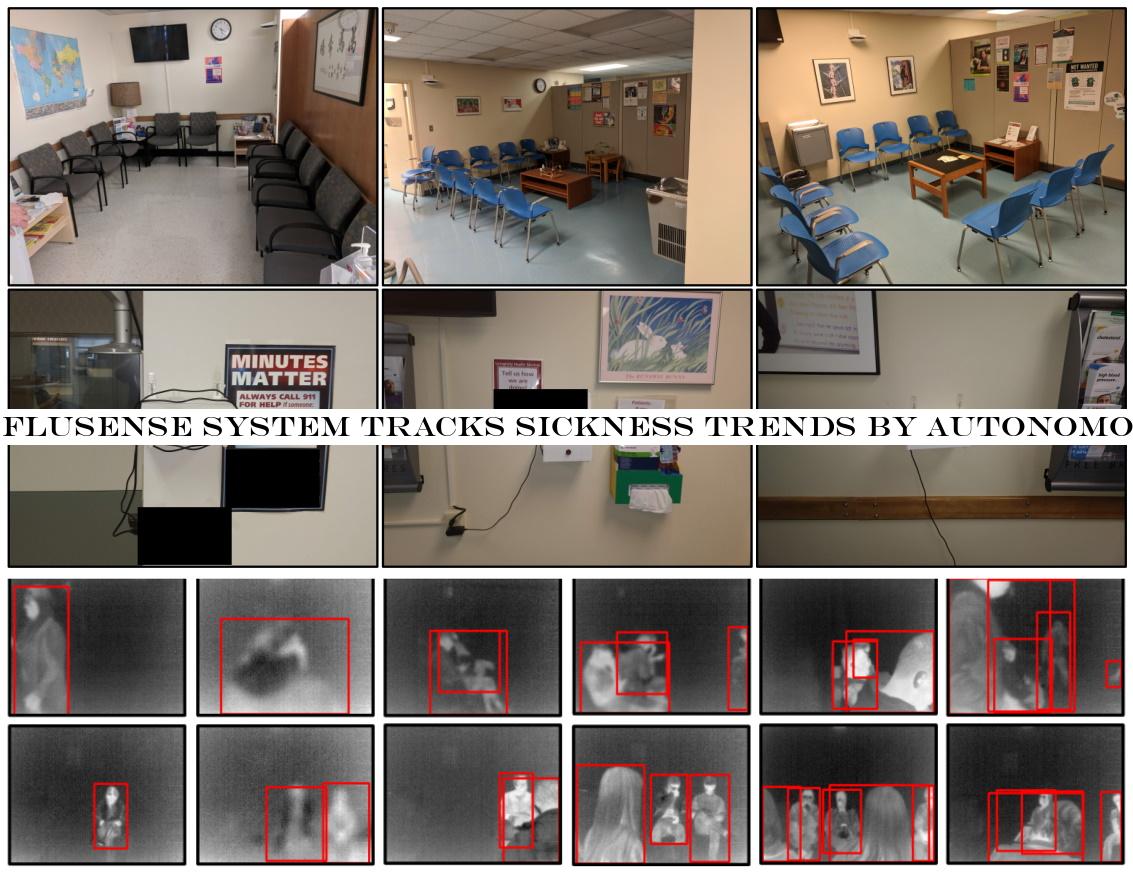
A sample setup, above, the FluSense prototype hardware, center, and sample output from the thermal camera with individuals being counted and outlined.
Sure, ita relatively simple measurement, but therenothing like this out there, even in places like clinic waiting rooms where sick people congregate; Admissions staff aren&t keeping a running tally of coughs for daily reporting. One can imagine not only characterizing the types of coughs, but visual markers like how closely packed people are, and location information like sickness indicators in one part of a city versus another.
&We believe that FluSense has the potential to expand the arsenal of health surveillance tools used to forecast seasonal flu and other viral respiratory outbreaks, such as the COVID-19 pandemic or SARS,& Rahman told TechCrunch. &By understanding the ebb and flow of the symptoms dynamics across different locations, we can have a better understanding of the severity of a novel infectious disease and that way we can enforce targeted public health intervention such as social distancing or vaccination.&
Obviously privacy is an important consideration with something like this, and Rahman explained that was partly why they decided to build their own hardware, since as some may have realized already, this is a system thatpossible (though not trivial) to integrate into existing camera systems.
&The researchers canvassed opinions from clinical care staff and the university ethical review committee to ensure the sensor platform was acceptable and well-aligned with patient protection considerations,& he said. &All persons discussed major hesitations about collection any high-resolution visual imagery in patient areas.&
Similarly, the speech classifier was built specifically to not retain any speech data beyond that someone spoke — can&t leak sensitive data if you never collect any.
The plan for now is to deploy FluSense &in several large public spaces,& one presumes on the UMass campus in order to diversify their data. &We are also looking for funding to run a large-scale multi-city trial,& Rahman said.
In time this could be integrated with other first- and second-hand metrics used in forecasting flu cases. It may not be in time to help much with controlling COVID-19, but it could very well help health authorities plan better for the next flu season, something that could potentially save lives.
- Details
- Category: Technology Today
Read more: FluSense system tracks sickness trends by autonomously monitoring public spaces
Write comment (91 Comments)During two of this weekWhite House briefings, President Trump referred specifically to two potential treatments that have been identified by medical researchers and clinicians, and that have undergone various degrees of investigation and testing in the ongoing fight against the global coronavirus pandemic. Itimportant to note upfront that regardless of what you may have heard, from Trump or any other sources, no drugs or treatments have been proven as effective for either the prevention of contracting COVID-19 or for its treatment.
That said, a number of different clinical studies are currently in progress all over the world, and in the U.S., the National Institutes of Health is looking to fill a 400-volunteer study that will provide clinical results related to use of remdesivir, an antiviral drug developed by Gilead originally as a treatment for Ebola, but itstill only in clinical trials even for treatment of that disease. This study could also add other drug candidates as additional test therapies. Meanwhile, studies in China and France have examined the effectiveness of anti-malarial drugs, including chloroquine and hydroxychloroquine — including one small-scale study that suggests the positive effects of hydroxycholoroquine in reducing both the duration and symptoms of COVID-19 in combination with an antibiotic called azithromycin.
The important thing to keep in mind when considering these or any other potential treatments for the novel coronavirus, which is still relatively young, is that a lot of what we know about them so far is effectively anecdotal, and based not on the kind of scientifically rigorous controlled clinical studies that are normally used in the years-long development and certification of drugs. Instead, treatments like remdesivir and chloroquine/hydroxychloroquine are being deployed in the field by healthcare practitioners based on their approved use in similar (but crucially not the same) situations, like the Ebola and SARS outbreaks.
Often, they&re being used under whatcalled &compassionate& grounds in the U.S. This effectively amounts to employing a drug thatnot yet certified for general use in treatment of a patient whose condition is so severe that a doctor is willing to go to desperate lengths to try to alleviate their symptoms. This has the advantage of sidestepping typical testing and approval procedures, and requiring that the results of its use are documented, which contributes to the overall body of clinical knowledge in terms of its effects and interactions with patients and with COVID-19.
Itnot a clinical study, however, and that means there are still a lot of unknowns when it comes to its use that just can&t be learned or asserted based on scattered, individual instances of compassionate care treatment.
&As the Commissioner of FDA and the president mentioned yesterday, we&re trying to strike a balance between making something with the potential of an effect available to the American people, at the same time that we do it under the auspices of a protocol that would give us information to determine if ittruly safe and truly effective,& explained National Institute of Allergy and Infectious Diseases Director Dr. Anthony Fauci during a press conference on Friday. &But the information that you&re referring to specifically is anecdotal, it was not done in a controlled clinical trial. So you really can&t make any definitive statement about it.&
During ThursdayWhite House coronavirus pandemic task force briefing, Trump made false claims that chloroquine was already approved by the FDA as a treatment for COVID-19 under an emergency authorization. FDA Director Dr. Stephen Hahn clarified that this and remdesivir were being considered and studied by the FDA, as was an approach that would use plasma extracted from patients who&d recovered from COVID-19, as a potential source of antibodies for others. Still, all of these are still quite far away from clinical deployment in any generally approved way.
Meanwhile, Faucicautions should be taken for what they are: Warnings that are primarily meant to emphasize that the reason the FDA requires clinical studies, even for drugs already tentatively approved for use in other cases, is because it has patient health and safety in mind. While chloroquine has been used for decades to treat malaria, and chronic rheumatoid arthritis, it can have dangerous side effects, including death, if taken incorrectly. Even when taken correctly, it can cause things like stomach distress, and even permanent damage to a personvision.
Faucicomments Friday explain the risks of putting too much stock in any potential treatment at this stage, even if they are showing promising results among small or even medium-sized deployments.
&You&ve got to be careful when you say ‘fairly effective,& it was never done in a clinical trial that compared it to anything,& he said in answer to a reporterquestion about chloroquineefficacy in treating SARS. &It was given to individuals and felt that maybe it worked […] Whenever you do a clinical trial, you do standard of care, versus standard of care plus the agent you&re evaluating. Thatthe reason why we showed back in Ebola why particular interventions worked.&
A summary survey of various prospective treatments and their current status was published today In Medscape, and this includes the current state of remdesivir and chloroquine investigations, as well as a number of other drugs being studied by researchers. As has been reported here and elsewhere, there are promising signs that they could prove effective in either treatment, or treatment and even preventative use (in the case of remedesivir), but these are, as Dr. Fauci puts it, only the first step that should lead to more sophisticated clinical studies, which themselves will then need competing peer studies to eventually prove out.

- Details
- Category: Technology Today
Read more: Hydroxychloroquine, chloroquine and other potential COVID-19 treatments explained
Write comment (96 Comments)Elon Musk tweeted Friday that Tesla and SpaceX employees are &working on ventilators& even though he doesn&t believe they will be needed.
His confirmation on Twitter that both of the companies he leads are working on ventilators comes a day after New York City Mayor Bill de Blasiomade a direct plea to Musk to help alleviate a shortage at hospitals gearing up to combat COVID-19.
Itunclear how many employees are working on the ventilators and which Tesla factory — it could be Buffalo, N.Y., Fremont, Calif., Sparks, Nev. or even Shanghai — has dedicated space to the project. The SpaceX facility is located in Hawthorne, Calif.
Musk didn&t describe what capacity would be or how long it might take to scale up such an endeavor. One Twitter follower recommended building one large ventilator with multiple branches and lines. Musk noted that a single computer, pump and pressure accumulator could do the job, but noted that individual valves per patient would be ideal.
Whatever Musk decides, his project still faces specific obstacles. Certified medical personnel will need to be involved in such an operation and ventilator hardware used in clinical settings still must be approved by the FDA, which could delay production.
Still, the need for ventilators is urgent, prompting other automakers to investigate ways of ramping up production. GM, Volkswagen and Ford have all reportedly either talked to the White House or committed to looking at the problem. Volkswagen said Friday it has created a task force to look into using 3D printing to make hospital ventilators.
De Blasio tweeted out his plea to Musk Thursday morning. &Our country is facing a drastic shortage and we need ventilators ASAP — we will need thousands in this city over the next few weeks. We&re getting them as fast as we can but we could use your help!&
The mayoroffice has reached out to the person who runs Muskfamily office, his communications director and his lobbyist, press secretary Freddi Goldstein toldTechCrunchin an email. &Given his response on Twitter, we&re hopeful he will be able to help,& Goldstein added
The COVID-19 pandemic had elicited a seemingly conflicting mix of responses from Musk. He has downplayed COVID-19 in emails to employees and on social media. In one company-wide email sent to SpaceX employees, Musk wrote that they have a higher risk of being killed in a car crash than dying from the coronavirus, BuzzFeed reported last week.
Since then, Musk wrestled with officials in Alameda County to keep TeslaFremont, Calif., factory open, in spite of a government directive to close all non-essential businesses. Tesla announced plans Thursday to suspend production there beginning March 23.
Some basic operations that would supportTesla&scharging infrastructure and what it describes as its &vehicle and energy services operations& will continue at the factory, which under normal circumstances employs more than 10,000 people. Tesla is also suspending operations at its factory in Buffalo, N.Y., except for &those parts and supplies necessary for service, infrastructure and critical supply chains,& the company said in a statement.
Musk has jumped into crises before with mixed results. In 2018, Musk and the Musk Foundation donated $480,350 to add ultraviolet water filtration systems and water stations to all 12 area schools in Flint, Mich. The effort was delayed but eventually the systems were installed, beginning in fall 2019.
In 2018, he put SpaceX engineers to work on a pod that could be used to save children trapped in a flooded cave in Thailand. Rescuers didn&t use the device and an argument with a cave diving expert that played out on social media and national television led to a defamation lawsuit, after Musk repeatedly called him &pedo guy.& Musk was found not liable for defamation in a federal court in 2019.

- Details
- Category: Technology Today
Read more: SpaceX and Tesla are ‘working on’ ventilators, Elon Musk says
Write comment (90 Comments)When it comes to the entertainment industry, the COVID-19 outbreak isn&t just affecting movie theaters — it has also halted TV and film production around the world. For Netflix, that has included production on high-profile titles like &The Witcher& and &Stranger Things.&
So the streaming company just announced that it has created a $100 million fund that it says will support the cast and crew who have suddenly found themselves out of work.
In the announcement, Netflix Chief Creative Ted Sarandos said that there are now &hundreds of thousands of cast and crew without jobs,& including &electricians, carpenters and drivers, many of whom are paid hourly wages and work on a project-to-project basis.&
He said that most of this money will go to &the hardest hit workers on our own productions around the world& — though it sounds like the company is still figuring out exactly what form that support will take. (Sarandos noted that Netflix is already providing two weeks& pay to the productions suspended last week.)
In addition, Sarandos said $15 million will go to &third parties and non-profits providing emergency relief to out-of-work crew and cast in the countries where we have a large production base.&
In the United States, that includes $1 million each to the SAG-AFTRA COVID-19 Disaster Fund, the Motion Picture and Television Fund and the Actors Fund Emergency Assistance. In Canada, that includes $1 million that will be split between the AFC and Fondation des Artistes. Elsewhere, Sarandos said Netflix is &working with existing industry organizations to create similar creative community emergency relief efforts.&

- Details
- Category: Technology Today
Read more: Netflix announces $100M relief fund after TV and film production halted
Write comment (97 Comments)Twenty-eight percent of a nursetime is wasted on low-skilled tasks like fetching medical tools. We need them focused on the complex and compassionate work of treating patients, especially amid the coronavirus outbreak. Diligent Robotics wants to give them a helper droid that can run errands for them around the hospital. The startupbot Moxi is equipped with a flexible arm, gripper hand and full mobility so it can hunt down lightweight medical resources, navigate a clinichallways and drop them off for the nurse.
With the world facing a critical shortage of medical care professionals, Moxi could help healthcare centers use their staffs as efficiently as possible. And because robots can&t be infected by COVID-19, they&re one less potential carrier interacting with vulnerable populations.
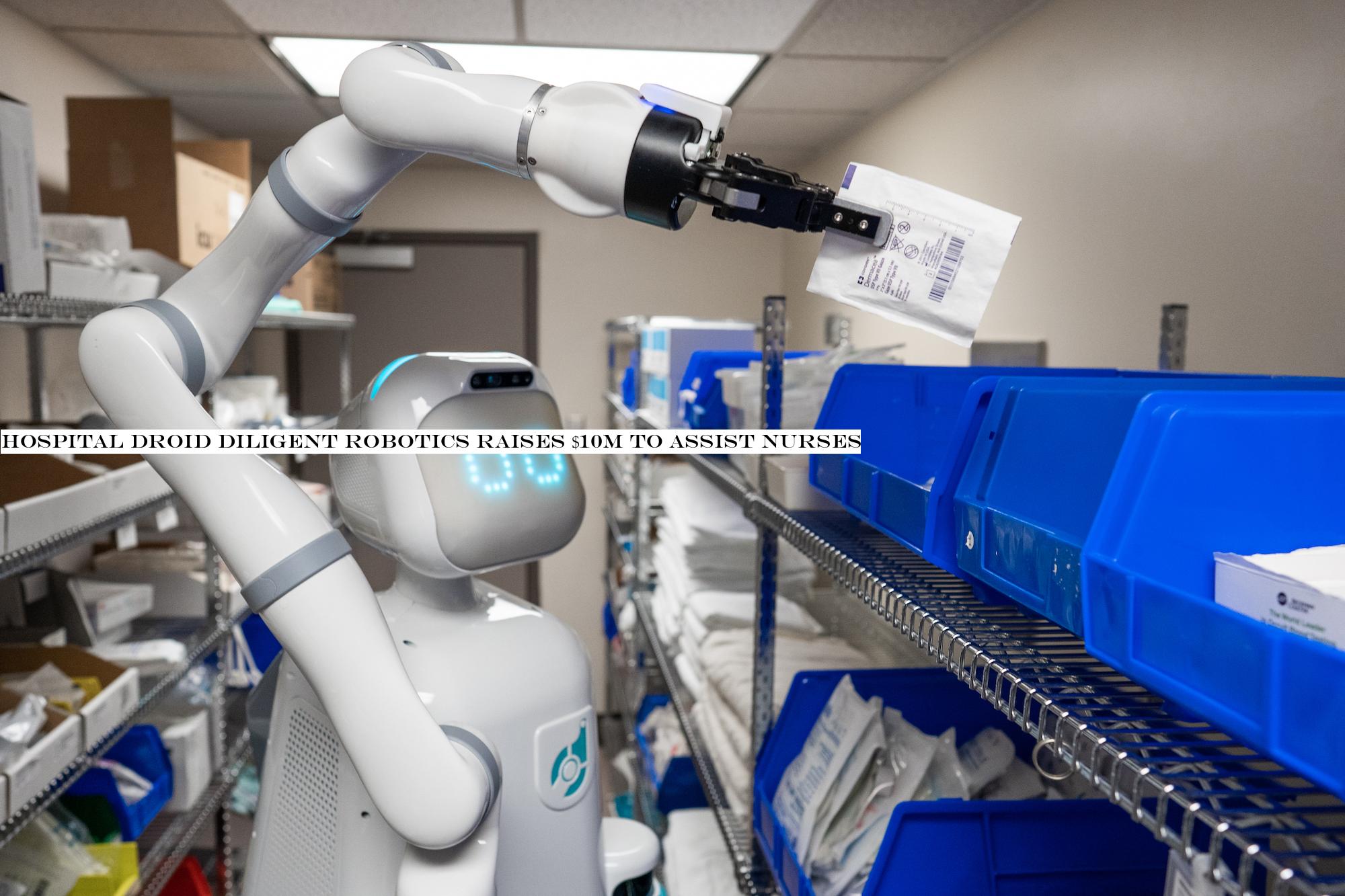
Today, Diligent Robotics announces its $10 million Series A that will help it scale up to deliver &more robots to more hospitals,& CEO Andrea Thomaz tells me. &We&ve been designing our product, Moxi, side by side with hospital customers because we don&t just want to give them an automation solution for their materials management problems. We want to give them a robot that frontline staff are delighted to work with and feels like a part of the team.&
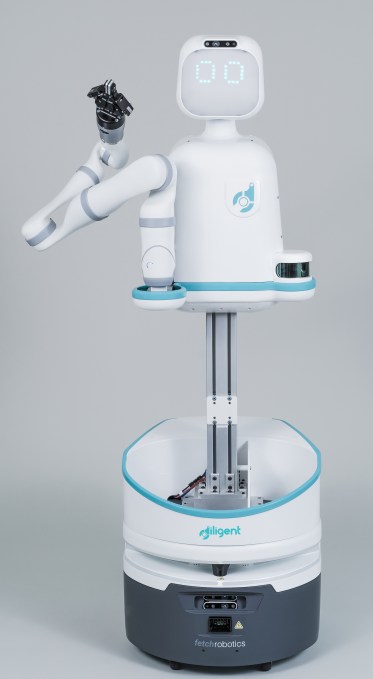 The round, led by DNX Ventures, brings Diligent Robotics to $15.75 million in total funding thatpropelled it to the fifth generation of its Moxi robot. It currently has two deployed in Dallas, Texas, but is already working with two of the three top hospital networks in the U.S. &As the current pandemic and circumstance has shown, the real heroes are our healthcare providers,& says Q Motiwala, partner at DNX Ventures. The new cash from DNX, True Ventures, Ubiquity Ventures, Next Coast Ventures, Grit Ventures, E14 Fund and Promus Ventures will help Diligent Robotics expand Moxiuse cases and seamlessly complement nurses& workflows to help alleviate the talent crunch.
The round, led by DNX Ventures, brings Diligent Robotics to $15.75 million in total funding thatpropelled it to the fifth generation of its Moxi robot. It currently has two deployed in Dallas, Texas, but is already working with two of the three top hospital networks in the U.S. &As the current pandemic and circumstance has shown, the real heroes are our healthcare providers,& says Q Motiwala, partner at DNX Ventures. The new cash from DNX, True Ventures, Ubiquity Ventures, Next Coast Ventures, Grit Ventures, E14 Fund and Promus Ventures will help Diligent Robotics expand Moxiuse cases and seamlessly complement nurses& workflows to help alleviate the talent crunch.
Thomaz came up with the idea for a hospital droid after doing her PhD in social robotics at the MIT Media lab. Her co-founder and CTO Vivian Chu had done a masterat UPenn on how to give robots a sense of touch, and then came to work with Thomaz at Georgia Tech. They were inspired by a study revealing how nurses spent so much time acting as hospital gofers, so in 2016 they applied for and won a National Science Foundation grant of $750,000 that funded a six-month sprint to build a prototype of Moxi.
Since then, 18-person Diligent Robotics has worked with hundreds of nurses to learn about exactly what they need from an autonomous assistant. &Today you will go about your day, and you probably won&t interact with any robots….we want to change that,& Thomaz tells me. &The only way you can really bring robots out of the warehouses, off of the factory floors, is to build a robot that can work in our dynamic and messy everyday human environments.& The startupintention isn&t to fully replace humans, which it doesn&t think is possible, but to let them focus on the most human elements of their jobs.
Moxi is about the size of a human, but designed to look like an &80s movie robot so as not to engender an uncanny valley cyborg weirdness. Its head and eyes can move to signal intent, like which direction itabout to move, while sounds let it communicate with nurses and acknowledge their commands. A moving pillar lets it adjust its height, while its gripper hand and arm can pick and put down smaller pieces of hospital equipment. Its round shape and courteous navigation makes sure it can politely share crowded hallways and travel via elevator.
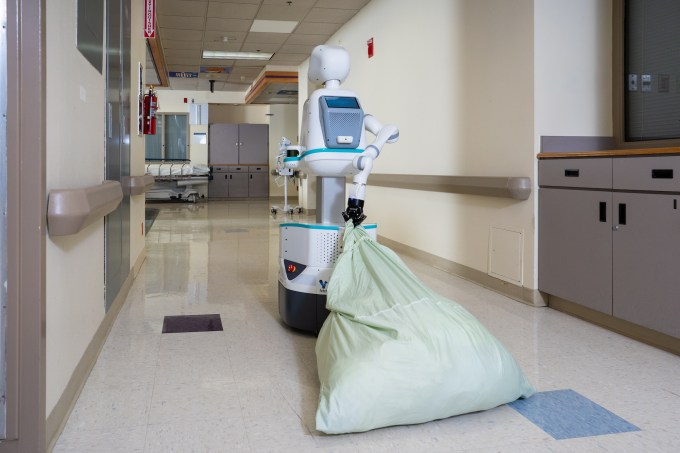
Diligent Robotics& solution engineers work with hospitals to teach Moxi how to get around and what they need. The company hopes to eventually build the ability to learn and adapt right into the bot so nurses can teach it new tasks on the fly. &The team continues to demonstrate unmatched robotics-specific innovation by combining social intelligence and human-guided learning capabilities,& says True Ventures partner and Diligent board member Rohit Sharma.
Hospitals pay an upfront fee to buy Moxi robots, and then therea monthly fee for the software, services and maintenance. Thomaz admits that &Hospitals are naturally risk-averse, and can be wary to take up new technology,& so the startup is taking a slow and steady approach to deployment so it can convince buyers that Moxi is worth the learning curve.
Diligent Robotics will be competing with companies like AethonTUG bot for pulling laundry and pharmacy carts. Other players in the hospital tech space include Xenexmachine that disinfects rooms with light, and surgical bots like those from Johnson - JohnsonAuris and Intuitive Surgical.
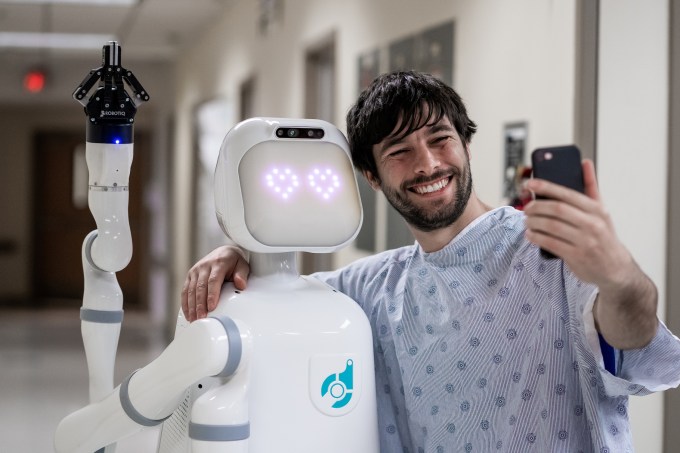
Diligent Robotics hopes to differentiate itself by building social intelligence into Moxi so it feels more like an intern than a gadget. &Time and again, we hear from our hospital partners that Moxi not only returns time back to their day but also brings a smile to their face,& says Thomaz. The company wants to evolve Moxi for other dull, dirty or dangerous service jobs.
Eventually, Diligent Robotics hopes to bring Moxi into peoplehomes. &While we don&t see robots replacing the companionship and the human connection, we do dream of a time that robots could make nursing homes more pleasant by offsetting the often staggering numbers of caretakers to bed ratios (as bad as 30:1),& Thomaz concludes. That way, Moxi could &help people age with dignity and hold onto their independence for as long as possible.&

- Details
- Category: Technology Today
Read more: Hospital droid Diligent Robotics raises $10M to assist nurses
Write comment (93 Comments)Page 1153 of 1418

 17
17





